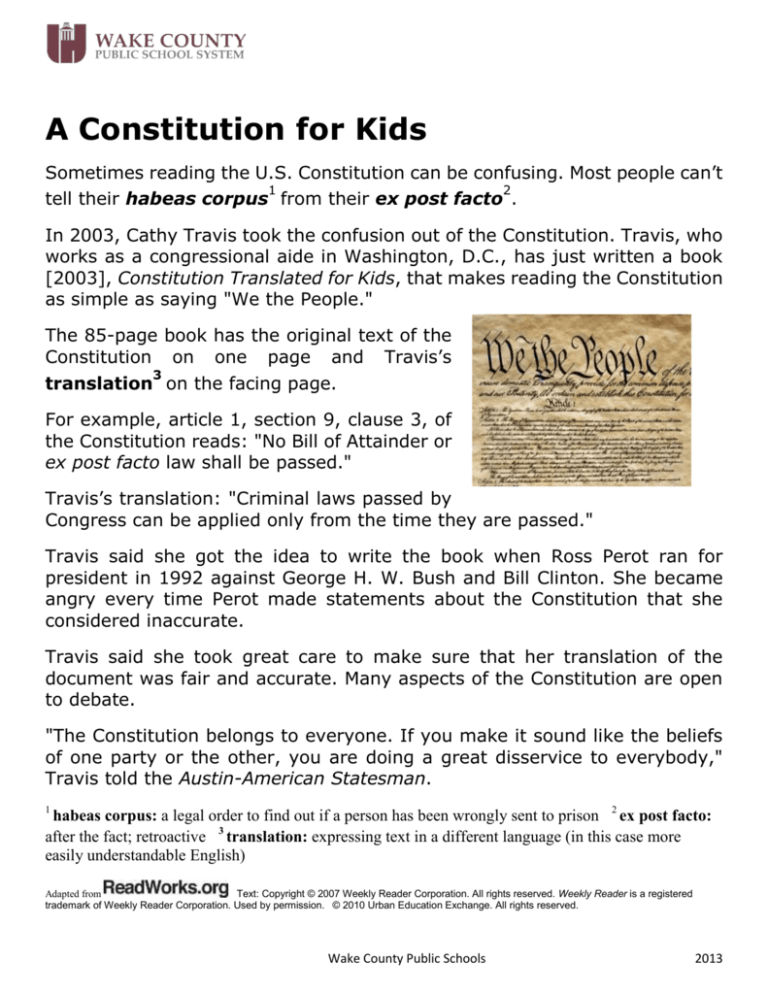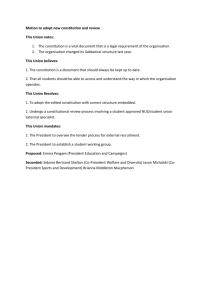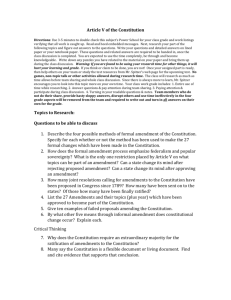
A Constitution for Kids
Sometimes reading the U.S. Constitution can be confusing. Most people can’t
1
2
tell their habeas corpus from their ex post facto .
In 2003, Cathy Travis took the confusion out of the Constitution. Travis, who
works as a congressional aide in Washington, D.C., has just written a book
[2003], Constitution Translated for Kids, that makes reading the Constitution
as simple as saying "We the People."
The 85-page book has the original text of the
Constitution on one page and Travis’s
3
translation on the facing page.
For example, article 1, section 9, clause 3, of
the Constitution reads: "No Bill of Attainder or
ex post facto law shall be passed."
Travis’s translation: "Criminal laws passed by
Congress can be applied only from the time they are passed."
Travis said she got the idea to write the book when Ross Perot ran for
president in 1992 against George H. W. Bush and Bill Clinton. She became
angry every time Perot made statements about the Constitution that she
considered inaccurate.
Travis said she took great care to make sure that her translation of the
document was fair and accurate. Many aspects of the Constitution are open
to debate.
"The Constitution belongs to everyone. If you make it sound like the beliefs
of one party or the other, you are doing a great disservice to everybody,"
Travis told the Austin-American Statesman.
1
habeas corpus: a legal order to find out if a person has been wrongly sent to prison
2 ex post facto:
after the fact; retroactive
3 translation: expressing text in a different language (in this case more
easily understandable English)
Adapted from
Text: Copyright © 2007 Weekly Reader Corporation. All rights reserved. Weekly Reader is a registered
trademark of Weekly Reader Corporation. Used by permission.
© 2010 Urban Education Exchange. All rights reserved.
Wake County Public Schools
2013
The Constitution: The Forgotten Amendment
Most educated people of the eighteenth
construed to deny or disparage others retained
century, such as the Founding Fathers,
by the people. Meaning in simpler language,
supported the idea of Natural Rights Theory.
that certain rights listed in the Constitution shall
Meaning every human has a considerable
not mean that other rights of the people are
number of natural rights, because they are a
denied.
human person.
Today, two views are held as to what this
When the US Constitution was sent to the states
amendment really means. One view is that all
for ratification or approval, many people at that
rights have been included in the Constitution
time felt that the federal government, according
and anything not listed is just present in our lives
to the Constitution, would be too strong. They
and traditions. The other view holds that the
were concerned that rights of individual citizens
language of the Ninth Amendment allows for
versus the government were not clear enough.
rights the Founding Fathers couldn’t have
This led to the creation of the Bill of Rights,
which are the first ten amendments. They were
ratified or approved by the states at the same
time as the Constitution. The first eight of these
amendments list specific rights of citizens, but
some leaders feared that listing some rights
could be misunderstood to mean that citizens
didn’t have other, unlisted rights. To help with
this possible misunderstanding, James Madison
and others produced the Ninth Amendment,
which states:
The enumeration in the
Constitution, of certain rights, shall not be
imagined in their time such as a woman’s right
to vote.
So far a majority of the Supreme Court has not
agreed with either interpretation, preferring to
ignore the Ninth Amendment altogether. As
such, most Supreme Court cases use other
amendments when making their final rulings
and why many scholars call it the forgotten
amendment.
Adapted from The Words We Live By-Your Annotated
Guide to the Constitution by Linda R. Monk
Wake County Public Schools
2013










